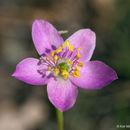Comments
provided by eFloras
Within the overall area of its distribution, Phemeranthus rugospermus is nowhere abundant, its occurrence being everywhere spotty and localized. According to T. S. Cochrane (1993), the disjunctions probably reflect a history of long-distance dispersal from a center in the partially unglaciated Kansas and Nebraska sandhills, the present-day gaps resulting from a paucity of suitable habitats between that area and the others where it is now found. Even so, its discovery in Missouri, Arkansas, and/or Oklahoma would not be surprising.
- license
- cc-by-nc-sa-3.0
- copyright
- Missouri Botanical Garden, 4344 Shaw Boulevard, St. Louis, MO, 63110 USA
Description
provided by eFloras
Plants to 2.5 dm; roots elongate, fleshily woody. Stems ± erect, simple or sometimes branching. Leaves sessile; blade terete, to 6 cm. Inflorescences cymose, much overtopping leaves; peduncle scapelike, to 15 cm. Flowers: sepals deciduous, ovate, 4 mm; petals pink to magenta, ovate to obovate, sometimes mucronulate, 6.5-8 mm; stamens 12-28; stigmas 3, spreading widely, linear, 1/2-1/3 as long as styles. Capsules subglobose, 4 mm. Seeds without arcuate ridges, 1.2 mm, corrugate-rugulose overall. 2n = 24.
- license
- cc-by-nc-sa-3.0
- copyright
- Missouri Botanical Garden, 4344 Shaw Boulevard, St. Louis, MO, 63110 USA
Distribution
provided by eFloras
Ill., Ind., Iowa, Kans., La., Minn., Nebr., Tex., Wis.
- license
- cc-by-nc-sa-3.0
- copyright
- Missouri Botanical Garden, 4344 Shaw Boulevard, St. Louis, MO, 63110 USA
Flowering/Fruiting
provided by eFloras
Flowering May-Aug.
- license
- cc-by-nc-sa-3.0
- copyright
- Missouri Botanical Garden, 4344 Shaw Boulevard, St. Louis, MO, 63110 USA
Habitat
provided by eFloras
Sand or sandy soils, dunes, mounds, flats, banks, ridges, edges of igneous or metamorphic rock outcrops, along or near watercourses; 0-500m.
- license
- cc-by-nc-sa-3.0
- copyright
- Missouri Botanical Garden, 4344 Shaw Boulevard, St. Louis, MO, 63110 USA
Synonym
provided by eFloras
Talinum rugospermum Holzinger, Asa Gray Bull. 7: 117, fig. 1a-c. 1899
- license
- cc-by-nc-sa-3.0
- copyright
- Missouri Botanical Garden, 4344 Shaw Boulevard, St. Louis, MO, 63110 USA
Comprehensive Description
provided by North American Flora
Talinum rugospermum Holz. Asa Gray Bull. 7: 117. 1899
A perennial herb, 1-2.3 dm. tall, the root deep, the stems short; leaf-blades terete, 1.5-6 cm. long, 1-1.6 mm. thick, acute; inflorescence a cyme, bracted at the forks; peduncles slender, 7-13 cm. long; pedicels slender; sepals ovate to broadly ovate, 3.8-4 mm. long, 3.6-4 mm. broad, obtuse or acutish at the apex, early-deciduous; petals ovate, elliptic, or sometimes obovate, 6.5-8 mm long, 2.4-5 mm. broad, obtuse or acute at the apex; stamens 12-25, the filaments slender, pinkish, the anthers very short, nearly circular in outline; style split for one third its length into three slender stigmatic lobes; capsule subglobose, about 4-4.2 mm. in diameter; seeds 1 mm. long, 0.9-1 mm wide, wrinkled.
Type locality Trempeleau Prairie, Wisconsin.
DuTBiBunoM Minnesota, Wisconsin, Illinois, and Indiana.
Illubtbath Bull. 7 Britt. & Brown, IU. Fl. ed. 2./. 1737.
- bibliographic citation
- Percy Wilson, Per Axel Rydberg. 1932. CHENOPODIALES. North American flora. vol 21(4). New York Botanical Garden, New York, NY
Phemeranthus rugospermus
provided by wikipedia EN
Phemeranthus rugospermus is a species of flowering plant in the miner's lettuce family, Montiaceae, known by the common names prairie fameflower, rough-seeded fameflower, and flower-of-an-hour. It is native to the central United States from Texas and Louisiana north to Nebraska, Minnesota, and Wisconsin.[2][3]
Phemeranthus rugospermus is a perennial herb growing up to 25 centimeters (10 inches) tall with an erect branching or unbranched stem. The cylindrical leaves are up to 6 centimeters (2.4 inches) long. The pink flowers arise on a tall stalk. The capsules contain wrinkly seeds.[4] The flowers open for one day, and only in the afternoon.[2]
Phemeranthus rugospermus grows in open habitat where there is little competition from other plants, such as rock outcrops, stretches of sand, or open woods. It can be found on dunes along the banks of the Mississippi River. It benefits from low levels of disturbance, such as fires.[2] Human-caused forms of disturbance, such as off-road vehicle activity, can be beneficial at times.[3] Other plants in the habitat may include Andropogon scoparius, Selaginella rupestris, Opuntia compressa, Panicum virgatum, Allium stellatum, Isanthus brachiatus, Houstonia longifolia, and Ambrosia artemisiifolia.[2]
References

- license
- cc-by-sa-3.0
- copyright
- Wikipedia authors and editors
Phemeranthus rugospermus: Brief Summary
provided by wikipedia EN
Phemeranthus rugospermus is a species of flowering plant in the miner's lettuce family, Montiaceae, known by the common names prairie fameflower, rough-seeded fameflower, and flower-of-an-hour. It is native to the central United States from Texas and Louisiana north to Nebraska, Minnesota, and Wisconsin.
Phemeranthus rugospermus is a perennial herb growing up to 25 centimeters (10 inches) tall with an erect branching or unbranched stem. The cylindrical leaves are up to 6 centimeters (2.4 inches) long. The pink flowers arise on a tall stalk. The capsules contain wrinkly seeds. The flowers open for one day, and only in the afternoon.
Phemeranthus rugospermus grows in open habitat where there is little competition from other plants, such as rock outcrops, stretches of sand, or open woods. It can be found on dunes along the banks of the Mississippi River. It benefits from low levels of disturbance, such as fires. Human-caused forms of disturbance, such as off-road vehicle activity, can be beneficial at times. Other plants in the habitat may include Andropogon scoparius, Selaginella rupestris, Opuntia compressa, Panicum virgatum, Allium stellatum, Isanthus brachiatus, Houstonia longifolia, and Ambrosia artemisiifolia.
- license
- cc-by-sa-3.0
- copyright
- Wikipedia authors and editors

